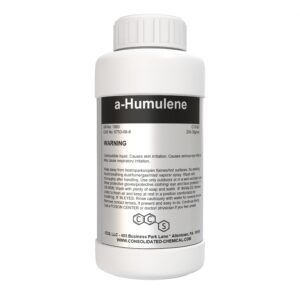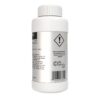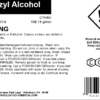Benzyl Alcohol – Laboratory Grade Multi-Purpose Solvent
$12.00 – $69.99
General Information
- Chemical Name: Benzyl Alcohol
- Synonyms: Phenylmethanol, Benzenemethanol
- CAS Number: 100-51-6
- EC Number: 202-859-9
- Molecular Formula: C₇H₈O
- Molecular Weight: 108.14 g/mol
- Grade: Industrial and Laboratory Grade
Physical Properties
- Appearance: Clear, colorless liquid
- Odor: Mild aromatic odor
- Purity: ≥ 99.9%
- Density: ~1.04 g/cm³ at 20°C
- Boiling Point: ~205°C
- Freezing Point: ~-15°C
- Flash Point: ~93°C (Closed Cup)
- Refractive Index: 1.538–1.541 at 20°C
- Solubility:
- Slightly soluble in water (4 g/100 mL at 25°C)
- Fully miscible with most organic solvents
Chemical Properties
- Stability:
- Stable under recommended storage and handling conditions.
- Reacts with oxidizing agents and acids.
- pH: Neutral (~7.0 in aqueous solution).
Description
Benzyl Alcohol is a high-purity, versatile solvent widely used in industrial, cosmetic, and pharmaceutical applications. Known for its low toxicity and mild aromatic properties, it serves as a critical ingredient in cosmetics, preservatives, chemical synthesis, and more. Its excellent solvency and gentle nature make it suitable for a variety of uses, from cleaning to formulations.
Applications of Benzyl Alcohol
Pharmaceutical Industry
- Preservative:
- Commonly used as a preservative in injectable medications, ensuring sterility and stability.
- Solvent:
- Dissolves active ingredients in topical creams, ointments, and drug formulations.
Cosmetics and Personal Care
- Preservative:
- Extends shelf life of lotions, shampoos, creams, and other cosmetic products by preventing microbial growth.
- Solvent:
- Stabilizes fragrances and other active ingredients in formulations.
- Humectant:
- Retains moisture, improving texture and usability of personal care products.
Industrial Applications
- Cleaning Agent:
- Effective for cleaning delicate surfaces, laboratory equipment, and medical instruments.
- Solvent:
- Used in the production of paints, coatings, and adhesives for its excellent solvency and stability.
Chemical Synthesis
- Reagent and Intermediate:
- Serves as a starting material in the synthesis of esters, resins, and specialty chemicals.
Laboratory Use
- Sample Preparation:
- Widely used as a solvent in chromatography, chemical analysis, and other laboratory procedures.
- Preservation:
- Used for preserving biological specimens and tissue samples.
Flavor and Fragrance Industry
- Fragrance Carrier:
- Enhances and stabilizes fragrances in perfumes and scented products.
- Flavoring Agent:
- Occasionally used as a carrier or stabilizer in certain food-grade applications.
Paints and Coatings
- Solvent:
- Improves flow and application properties in paints, varnishes, and coatings.
Medical Applications
- Anesthetic:
- Used as a local anesthetic in dermatological and other medical applications.
Storage Instructions
- Temperature Control:
- Store in a cool, dry, and well-ventilated area at temperatures below 25°C (77°F) to ensure stability.
- Protect from Light:
- Keep away from direct sunlight, as exposure may degrade the product.
- Sealed Containers:
- Ensure containers are tightly closed to prevent contamination and evaporation. Use chemical-resistant containers.
- Incompatibilities:
- Store away from strong oxidizing agents, acids, and bases.
Handling Instructions
- Personal Protective Equipment (PPE):
- Always wear chemical-resistant gloves, safety goggles, and protective clothing to prevent skin and eye contact.
- Ventilation:
- Use in a well-ventilated area or under a fume hood to minimize vapor exposure.
- Safe Transfer:
- Use clean, dry tools and equipment to transfer the product, ensuring containers are properly sealed after use.
- Spill Management:
- For small spills: Absorb with inert materials such as sand or spill pads. Dispose of waste in accordance with local regulations.
- For large spills: Contain the liquid and collect it for proper disposal.
Fire and Explosion Precautions
- Flammability: Combustible liquid. Keep away from heat, open flames, and ignition sources.
- Extinguishing Media: Use foam, CO₂, dry chemical, or water spray to extinguish fires.
- Firefighting: Wear self-contained breathing apparatus (SCBA) and full protective gear.
Disposal
Dispose of unused product, contaminated materials, and packaging in compliance with local, state, and federal regulations. Avoid releasing into drains, soil, or waterways.
Additional information
| Size | 100mL (3.3 Fl Oz), 250mL (8 Fl Oz), 500mL (16 Fl Oz), 1000mL (32 Fl Oz), 1 Gallon (128 Fl Oz) |
|---|
Related products
-

Dihydroterpineol (Menthanol) Aroma/Flavor Compound High Purity
$12.00 – $32.00 Select options This product has multiple variants. The options may be chosen on the product page -

1-Octanol (Alcohol C-8) Premium Aroma Fragrance Compound
$12.00 – $95.00 Select options This product has multiple variants. The options may be chosen on the product page -

Beta-Pinene (Natural) – High-Purity Aroma Compound
$11.00 – $42.00 Select options This product has multiple variants. The options may be chosen on the product page -

Alpha-Humulene | Premium Fragrance\Aroma Compound
$17.00 – $64.99 Select options This product has multiple variants. The options may be chosen on the product page























